Bempton Cliffs
The cliffs rise even higher out of the sea at nearby Bempton, which is the site of the famous RSPB Bird Sanctuary. An awe-inspiring sight, the sheer cliffs are home to many species. In particular, during the season puffins may be seen in large numbers, in addition to the thousands of other nesting birds who make this the largest such colony in England. Constant pounding by the North Sea has eroded the soft chalk, creating many unusual formations, secret caves (a past haven for smugglers), and secluded bays and inlets, including the picturesque North Landing where the old Flamborough Lifeboat was housed at the top of steep slipway. The following information is reproduced from the Royal Society for the Protection of Birds' web-site: "With over three miles of sheer cliffs, rising to 400 feet/122 m, Bempton is the best place in England to see breeding seabirds (over 200,000). Five safe viewing points give spectacular close-up views of puffins, gannets, guillemots, razorbills, kittiwakes and fulmars between April and mid-August. At other times there are migrating birds to be seen and possibly seals and porpoises. The shop has an extensive range of RSPB goods and books." The Reserve is open at all times, while the Visitor centre is open from 10 am to 5 pm March to November, and 9.30 am to 4 pm December to February (Closed 24 December to 3 January).

As the range of our activities is so diverse, we have a number of different websites. The main Flamborough Manor
site, which is where you are now, focuses primarily on accommodation (bed & breakfast) but has brief details of all
our other activities. To allow for more information to be presented on these other activities, we have other self-
contained web-sites and some of the links you will encounter while browsing these pages will take you to these
separate sites. To return to this site, simply go to the LINKS page, which is common to all our sites.

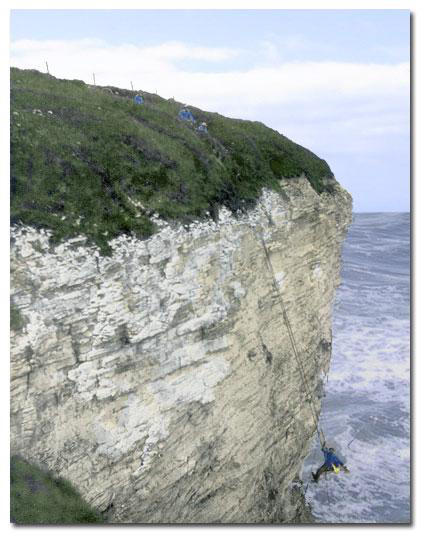
Shown at right is an old photograph of "climmers" at Bempton
Cliffs. Used as a method of supplementing incomes,
"climming" involved lowering men over the edge of the cliffs to
collect eggs from nesting sea birds. With virtually no safety
equipment (a cap stuffed with straw as some protection
against falling rocks from above), three- to four-hundred eggs
could be collected in a day. Guillemot eggs, which are large for
the size of bird, were particularly sought after. Despite the
danger, few accidents were recorded. The practice declined
after the Second World War but continued until 1954 when it
was finally made illegal.
The climmer shown is wearing his Gansey as added protection
against the elements. For more information on Ganseys,
please visit our sister site:



Views of Flamborough Head
Bempton Cliffs and the Bird Reserve :
The hard chalk cliffs at Bempton rise are relatively resistant to
erosion and offer lots of sheltered headlands and crevices for
nesting birds. The cliffs run about 6 miles (10 km) from Flamborough
Head north towards Filey and are over 100 metres (330 ft) high at
points.
There are good walkways along the top of the cliffs and several well
fenced and protected observation points. Most times there will be
helpful bird watchers with a range of scopes and binoculars on
hand.
Gannets
Bempton Cliffs is home to the only mainland breeding colony of
gannets in England. The birds arrive at the colony from January and
leave in August and September.
Kittiwakes
Numerically the most common bird, around 10% of the United
Kingdom population of kittiwakes (Rissa tridactyla) nest here.
Puffins
The Atlantic puffins (Fratercula arctica) at Bempton Cliffs tend to
nest in rock crevices, whereas burrows are used at most U.K. sites.
The Bempton puffins mostly fly 25 miles (40 km) east to the Dogger
Bank to feed.
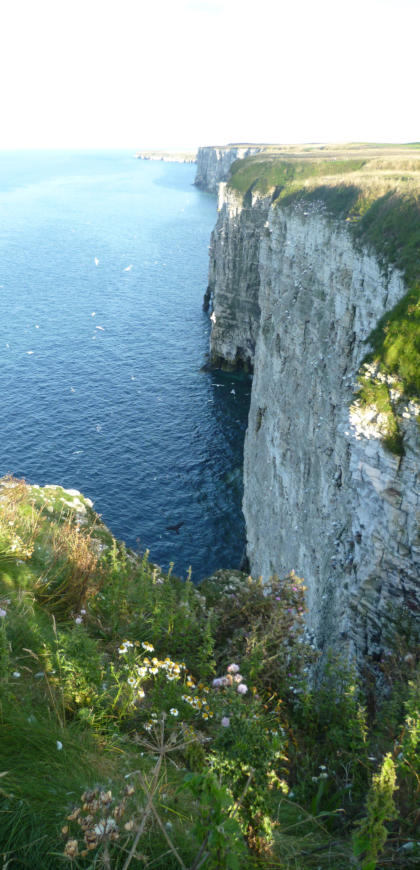
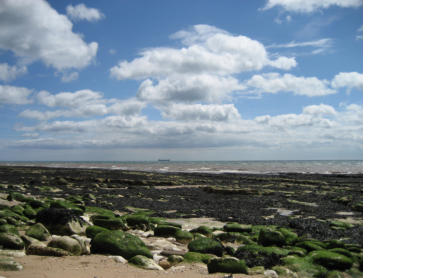


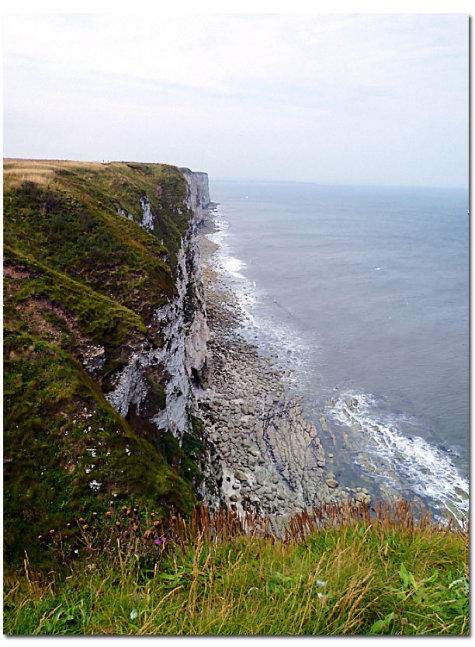
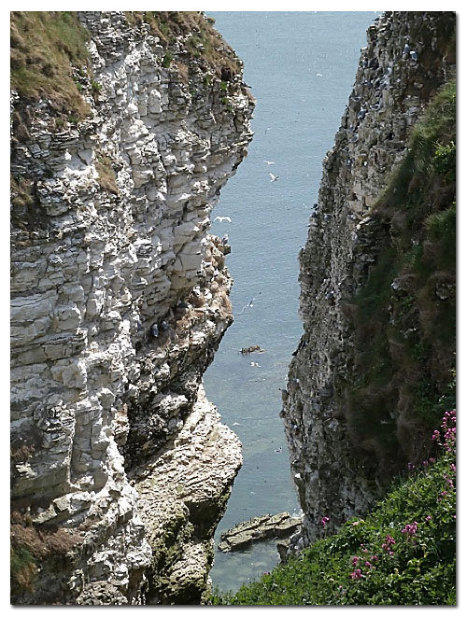
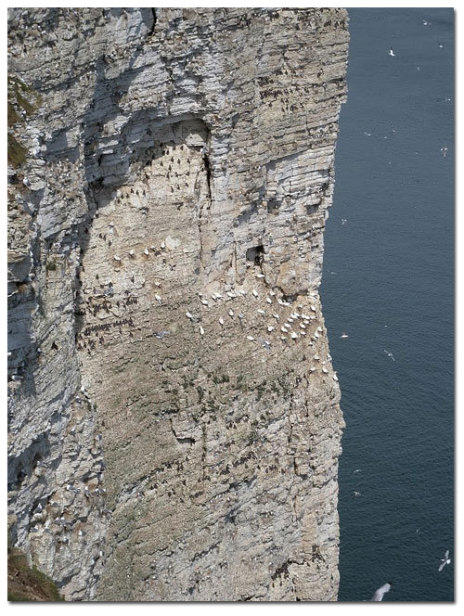


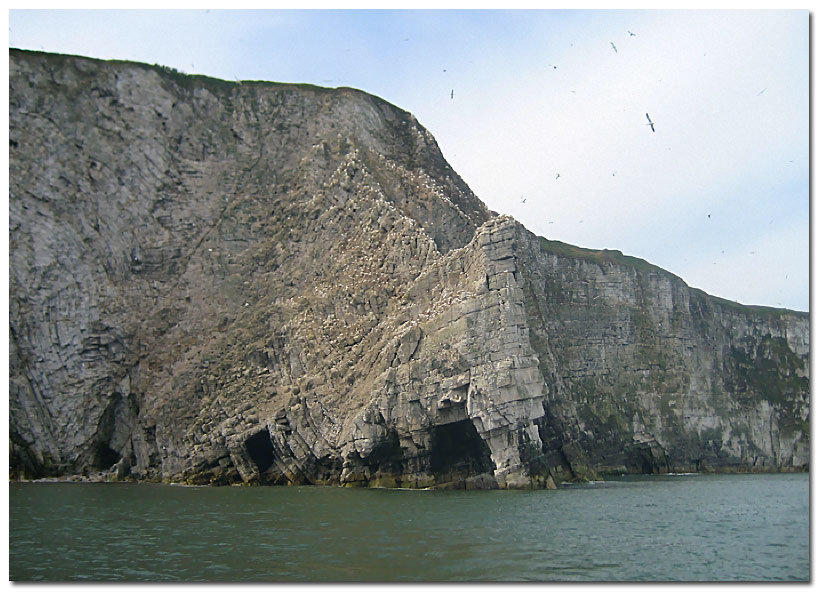
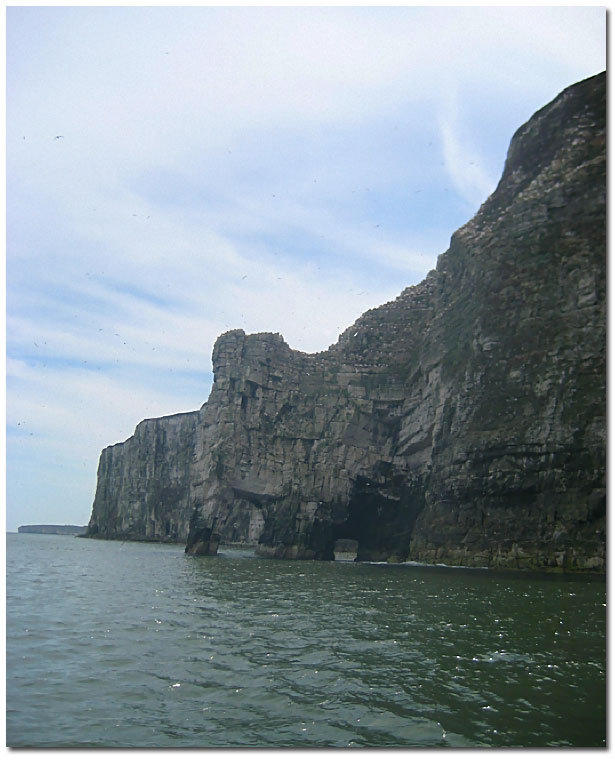
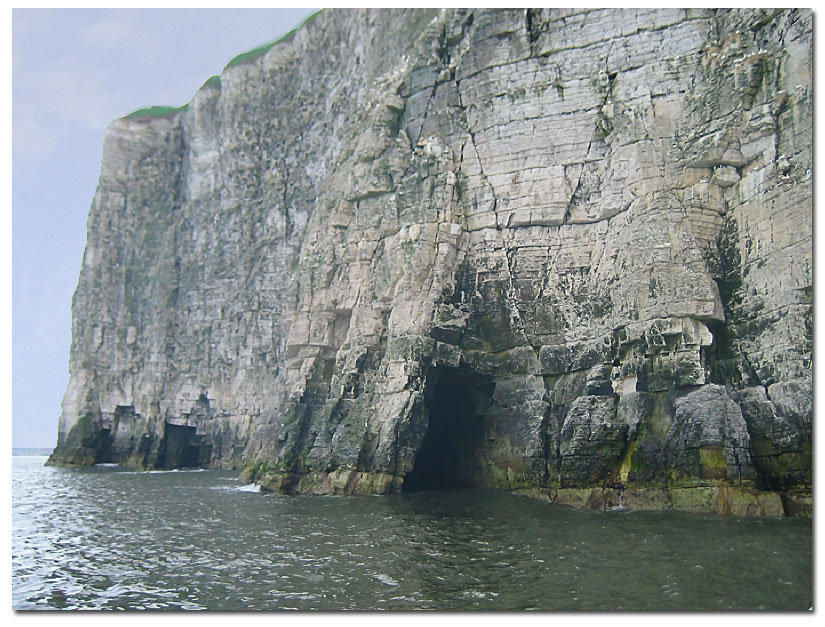
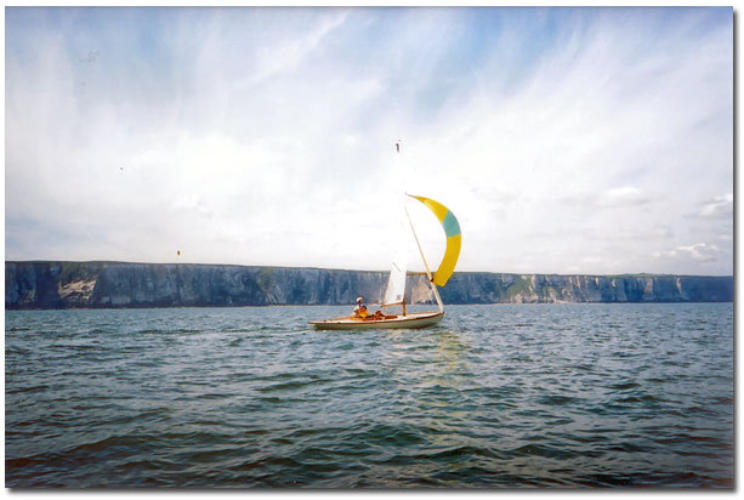
Flamborough Bird Observatory
Flamborough Bird Observatory, one of 19 similar watch-points across
Britain & Ireland, is a bird migration and population monitoring station
on Yorkshire’s east coast. Situated on an eight mile-long chalk
headland jutting out into the North Sea, like-minded volunteers have
worked over the last 40 years to record both migrant and local
breeding birds. Ringing takes place on both the outer head and at
Buckton; with the aim being to increase the knowledge of the
movement of migrants to and from their breeding grounds in Europe
and Asia. The conservation importance of Flamborough Head is
recognized by two European designations; it is a Special Protection
Area (SPA) for its breeding seabirds and is a Special Area of
Conservation (SAC) for its chalk reef and caves.
However, Flamborough is surely most renowned for its seabirds, with
the high chalk cliffs on its northern edge (including Bempton Cliffs
RSPB) famed for its breeding Gannets, Guillemot and Razorbill
populations, and huge Kittiwake colony. Sea-watching on the outer
head has proved that Flamborough is one of the very best places to
observe such passage in the North Sea. In autumn, winds from a
northerly quarter can induce movements of several hundred Sooty
Shearwaters daily, as well as occasional double-figure counts of Long-
tailed Skuas, and no fewer than eleven Feas’s-type Petrels.
Vying with its seabirds, Flamborough is increasingly cementing a
reputation for being one of the premier mainland sites for far-eastern
passerines, once the preserve of Shetland. In little more than a decade,
the headland has attracted the UK’s first ever Taiga Flycatcher, two
Brown Flycatchers, and two Brown Shrikes, whilst an Eastern
Olivaceous Warbler was appreciated by hundreds of visiting birders in
2010. In some years, the total of Pallas’s Warblers can approach
double-figures, whilst Yellow-browed Warblers are occasionally present
in such numbers daily.
Over the last decade, members of the observatory have worked with
landowners and the local council to open up a series of permissive
access routes across the headland. Why not join this enthusiastic
observatory team and help contribute to the growing knowledge of
how birds migrate through this breath-taking landscape.
Sailing under Bempton Cliffs in a Yorkshire One-Design (YOD) on a summer's day
The images below, showing the distinctive rock formations, were all taken from “The Yorkshire
Belle” which sails on a regular basis during the season from Bridlington Harbour
Bempton Cliffs, looking towards Filey Bay

The Manor House, Flamborough, Bridlington, East Riding of Yorkshire. YO15 1PD
Telephone: 01262 850943 [International: +44 1262 850943]
E-mail: gm@flamboroughmanor.co.uk
Web-site design & content Copyright © 2024 Geoffrey Miller
The Manor House
Accommodation, Books, Traditional Knitwear & Hand-Knitted Ganseys, Breton shirts
Lesley Berry and Geoffrey Miller
The Manor House
Flamborough
Bridlington
East Riding of Yorkshire YO15 1PD
United Kingdom
Telephone: 01262 850943 (Mobile 07718 415234)
International: +44 1262 850943
E-mail: gm@flamboroughmanor.co.uk
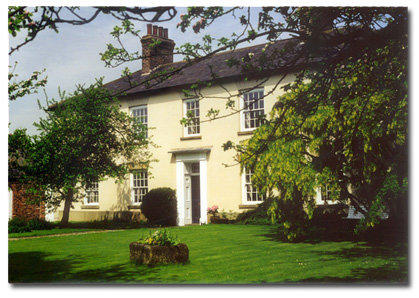
2024 Puffin/Shearwater/Skua cruise
timetables
All cruises take place aboard the Yorkshire Belle, which
leaves from the North Pier at Bridlington Harbour.
Booking essential
From the RSPB web-site: "Join us on the 'Yorkshire Belle' for a
spectacular cruise this summer! From May onwards, the cliffs of
Bempton and Flamborough become a little crowded with over
200,000 seabirds setting up home. Watch gannets flying overhead,
coming inshore to feed their young. The gannets are joined by
thousands of other seabirds, including kittiwakes, razorbills and
the colourful puffin. As well as flying overhead, you will see the
birds plunging head first into the sea around you, as the boat stirs
up some tasty treats. On the three-hour round trip from
Bridlington Harbour, ideal for both beginners and experienced
enthusiasts, you'll visit the spectacular chalk cliffs at Flamborough
Head. Just be sure you make an early reservation for your ringside
seat to our noisy seabird city."
For further details or to book a cruise please telephone
RSPB Bempton Cliffs on 01262 422211 or e-mail
bempton.cruises@rspb.co.uk.




Bempton Cliffs
The cliffs rise even higher out of the sea at nearby Bempton, which is the site of the famous RSPB Bird Sanctuary. An awe-inspiring sight, the sheer cliffs are home to many species. In particular, during the season puffins may be seen in large numbers, in addition to the thousands of other nesting birds who make this the largest such colony in England. Constant pounding by the North Sea has eroded the soft chalk, creating many unusual formations, secret caves (a past haven for smugglers), and secluded bays and inlets, including the picturesque North Landing where the old Flamborough Lifeboat was housed at the top of steep slipway. The following information is reproduced from the Royal Society for the Protection of Birds' web-site: "With over three miles of sheer cliffs, rising to 400 feet/122 m, Bempton is the best place in England to see breeding seabirds (over 200,000). Five safe viewing points give spectacular close-up views of puffins, gannets, guillemots, razorbills, kittiwakes and fulmars between April and mid-August. At other times there are migrating birds to be seen and possibly seals and porpoises. The shop has an extensive range of RSPB goods and books." The Reserve is open at all times, while the Visitor centre is open from 10 am to 5 pm March to November, and 9.30 am to 4 pm December to February (Closed 24 December to 3 January).
Shown above is an old photograph of "climmers" at Bempton Cliffs.
Used as a method of supplementing incomes, "climming" involved
lowering men over the edge of the cliffs to collect eggs from nesting
sea birds. With virtually no safety equipment (a cap stuffed with straw
as some protection against falling rocks from above), three- to four-
hundred eggs could be collected in a day. Guillemot eggs, which are
large for the size of bird, were particularly sought after. Despite the
danger, few accidents were recorded. The practice declined after the
Second World War but continued until 1954 when it was finally made
illegal.
The climmer shown is wearing his Gansey as added protection against
the elements. For more information on Ganseys, please visit our sister
site:


This is the mobile variant of our web-site, specially designed for
viewing on smartphones, but lacking some of the more detailed
information available on our full-size site..

Views of Flamborough Head

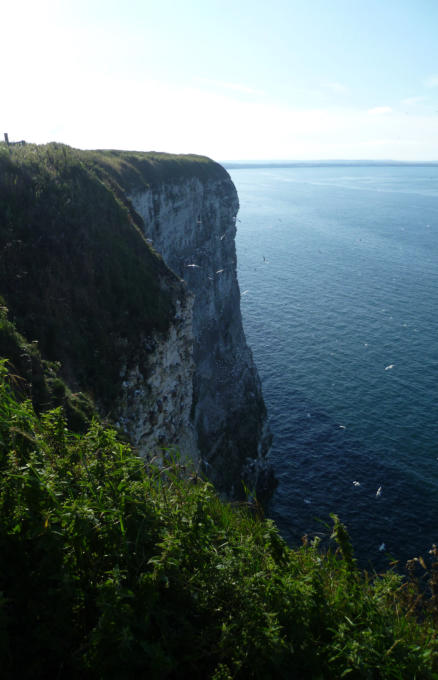
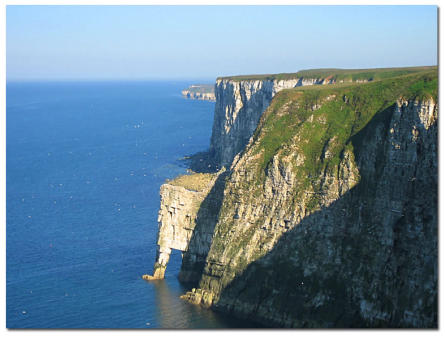
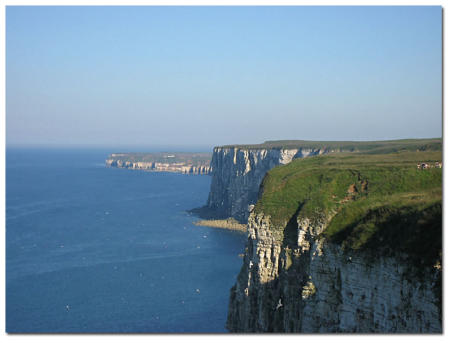

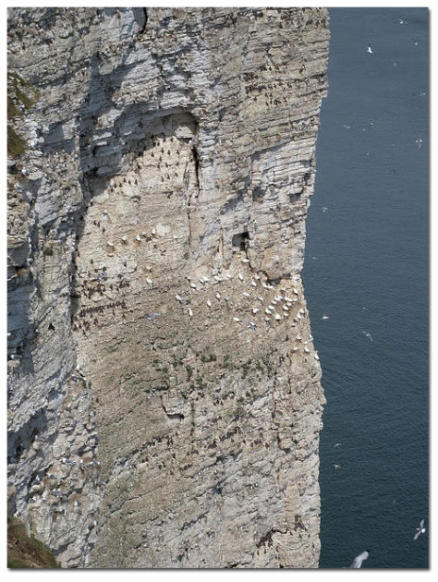
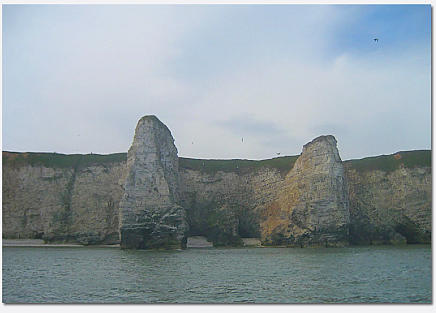


Flamborough Bird Observatory
Flamborough Bird Observatory, one of 19 similar watch-points across
Britain & Ireland, is a bird migration and population monitoring station
on Yorkshire’s east coast. Situated on an eight mile-long chalk
headland jutting out into the North Sea, like-minded volunteers have
worked over the last 40 years to record both migrant and local
breeding birds. Ringing takes place on both the outer head and at
Buckton; with the aim being to increase the knowledge of the
movement of migrants to and from their breeding grounds in Europe
and Asia. The conservation importance of Flamborough Head is
recognized by two European designations; it is a Special Protection
Area (SPA) for its breeding seabirds and is a Special Area of
Conservation (SAC) for its chalk reef and caves.
However, Flamborough is surely most renowned for its seabirds, with
the high chalk cliffs on its northern edge (including Bempton Cliffs
RSPB) famed for its breeding Gannets, Guillemot and Razorbill
populations, and huge Kittiwake colony. Sea-watching on the outer
head has proved that Flamborough is one of the very best places to
observe such passage in the North Sea. In autumn, winds from a
northerly quarter can induce movements of several hundred Sooty
Shearwaters daily, as well as occasional double-figure counts of Long-
tailed Skuas, and no fewer than eleven Feas’s-type Petrels.
Vying with its seabirds, Flamborough is increasingly cementing a
reputation for being one of the premier mainland sites for far-eastern
passerines, once the preserve of Shetland. In little more than a decade,
the headland has attracted the UK’s first ever Taiga Flycatcher, two
Brown Flycatchers, and two Brown Shrikes, whilst an Eastern
Olivaceous Warbler was appreciated by hundreds of visiting birders in
2010. In some years, the total of Pallas’s Warblers can approach
double-figures, whilst Yellow-browed Warblers are occasionally present
in such numbers daily.
Over the last decade, members of the observatory have worked with
landowners and the local council to open up a series of permissive
access routes across the headland. Why not join this enthusiastic
observatory team and help contribute to the growing knowledge of
how birds migrate through this breath-taking landscape.
The images below, showing the distinctive rock formations,
were all taken from “The Yorkshire Belle” which sails on a
regular basis during the season from Bridlington Harbour
Web-site design & content Copyright © 2019 Geoffrey Miller
The Manor House
Accommodation, Books, Traditional Knitwear &
Hand-Knitted Ganseys, Breton shirts
Lesley Berry and Geoffrey Miller
The Manor House
Flamborough
Bridlington
East Riding of Yorkshire YO15 1PD
United Kingdom
Telephone: 01262 850943 (Mobile 07718 415234)
International: +44 1262 850943
E-mail: gm@flamboroughmanor.co.uk

The Manor House
Flamborough
Bridlington
East Riding of Yorkshire
Telephone
01262 850943
2024 Puffin/Shearwater/Skua cruise timetables will be
available early Spring 2024.
All cruises take place aboard the Yorkshire Belle, which
leaves from the North Pier at Bridlington Harbour.
Booking essential
From the RSPB web-site: "Join us on the 'Yorkshire Belle' for a
spectacular cruise this summer! From May onwards, the cliffs of
Bempton and Flamborough become a little crowded with over 200,000
seabirds setting up home. Watch gannets flying overhead, coming
inshore to feed their young. The gannets are joined by thousands of
other seabirds, including kittiwakes, razorbills and the colourful puffin.
As well as flying overhead, you will see the birds plunging head first
into the sea around you, as the boat stirs up some tasty treats. On the
three-hour round trip from Bridlington Harbour, ideal for both
beginners and experienced enthusiasts, you'll visit the spectacular
chalk cliffs at Flamborough Head. Just be sure you make an early
reservation for your ringside seat to our noisy seabird city."
For further details or to book a cruise please telephone RSPB
Bempton Cliffs on 01262 422211 or e-mail
bempton.cruises@rspb.co.uk.

The Manor House, Flamborough, Bridlington, East Riding of Yorkshire. YO15 1PD
Telephone: 01262 850943 [International: +44 1262 850943]
E-mail: gm@flamboroughmanor.co.uk
Web-site design & content Copyright © 2024 Geoffrey Miller




























